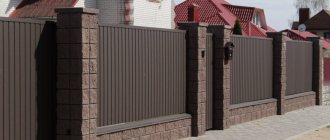For security, a strong fence with a gate is placed around the perimeter of the site with a residential building. To protect the entrance from penetration, you need a reliable lock on the gate. The lock is selected according to the material of the door, the method of opening, convenient for the people living in the house. It is also important what kind of lock for the gate the owner can buy and install with his own hands. An electric remote lock is included with the intercom. You can open it without leaving your home. It is enough to lock the dacha for the whole winter with an external canopy.
Mortise locking mechanism with additional security system
Types of wicket locks
- This device may have different mounting methods
- They also differ directly in their use, namely the opening
- The mechanism that is considered a locking mechanism can have various designs
All models also differ significantly in cost. The more complex the design, the more the device will cost. For example, an electromechanical lock will be much more expensive than one that is considered simply mechanical.
Special attention!
The reliability of any lock is determined by its class or resistance to opening. In total, there are four classes, of which the first is devices with the weakest security properties.
The fourth class, accordingly, is assigned to the most reliable locking mechanisms. The second, third and fourth classes are subject to mandatory certification, which is authorized to be carried out only by organizations and divisions that have the appropriate licenses. Therefore, for security reasons, it makes sense to study the accompanying documentation before purchasing a lock.
No matter how reliable it is, improper installation of the lock can affect both its service life and its security properties. It is better to trust such work to specialists, because dubious savings on the wages of a specialist can affect the safety of the site and your wallet. The only exception, perhaps, may be the unpretentious mechanics of not high class.
Methods of fastening locks
In addition to the fastening methods themselves, the street lock can be opened from one or both sides. The opening itself can be done either remotely or manually.
The most well-known method used to install this device is mounted.
Sometimes you can even hear the rather old name “barn”. This lock has earned this name because it is large in size, reliable, but not always convenient to use.
Today, such devices no longer have such huge sizes, but they remain just as reliable. Among all the models, there is a combination lock, as well as a cylinder lock.
Expensive quality
High-tech devices cannot be cheap. The high cost and complexity of installation, which cannot be carried out without the help of qualified specialists, is perhaps the only drawback of electronic and radio-controlled locks. However, this is compensated by the highest degree of intrusion protection that they provide.
A scanner or signal receiver, a control unit and a locking mechanism are the basis of any electronic device. The scanner can be configured for any of the biometric parameters of the site owners, so it is almost impossible for unauthorized persons to deceive it.
The control unit that receives the signal from the scanner and gives the command to open, close or block the locking mechanism is usually already located on the site, out of reach of possible intruders. And the locking mechanism itself is distinguished by a margin of strength and wear resistance.
An alternative or backup scanner can be a radio or infrared receiver. These types of electronic locks can be opened with key fobs that can unlock the gate from a distance.
Decorative plaster- Artificial turf - what are the advantages?
- What is a sludge pump and why is it needed?
Also common are video intercom kits with a lock, which allows owners to open the gate to visitors without leaving the house.
In case of problems with power supply, the design of electronic and radio-controlled devices provides for the installation of a battery. Thanks to this, regardless of the circumstances, the site is always under reliable protection.
Pros and cons of padlocks
One of the main advantages of such devices is the cost, which will be significantly lower than that of analogues. In addition, installing a lock does not require special training, which will save on calling a technician.
But while there are many advantages, there are many more disadvantages. Firstly, it is convenient to open it only from the side of the direct attachment, which is not always convenient.
There are also questions about the reliability of the device, since most of them can be opened with a typical crowbar. In addition, such a lock located on the gate is a signal for thieves.
Therefore, if you use it, for example, to close the gate at night from the inside, and even better in an area that is additionally guarded or equipped with cameras.
Overhead lock systems
Rim locks are distinguished by the presence of a body on the front and sides. The back wall of such products is always hidden by a wicket door. The thickness of the metal does not matter. The main requirement is strength.
Advantages:
- variety of design solutions;
- ease of installation;
- low cost;
- not visible from the street;
- Difficulty of breaking.
Characteristics of mortise locks
According to a large number of users, mortise locks for gates are the most suitable option for use. On the outside, a regular key is used to open such a device; on the inside, a turntable is turned on the lock.
Also, as a rule, the entire design includes a special latch that allows you to fix the door. To install a lock, you need special equipment, so you will most likely have to seek the help of specialists.
The entire structure is located inside the canvas, which means it is additionally protected from adverse weather conditions.
But when choosing a lock, you should take into account an important nuance, namely the parameters of the gate, or rather its thickness. If it is less than 40 mm, then installing the lock will be quite difficult, since most models are 25 mm.
Requirements for street locks
When buying a gate lock, you should take into account the fact that it will be located on the street. The lock must be reliably protected from moisture penetration, function properly in the cold and withstand exposure to the sun.
Experts recommend choosing an all-weather model for entering the local area. Such products are usually equipped with high-quality protection against external negative factors, including corrosion. Sometimes, for greater reliability, the lock is supplemented with a casing.
Description of electromagnetic locks
These magnetic locks are based on the same principle of operation as those models that are classified as electromechanical. The difference lies directly in the key. In these locks it is applied to a special button.
Sometimes a special code may also be entered, often installed in models in city houses. Not everyone finds the code convenient for use in the country.
The design has a significant disadvantage, namely, when the electrical power is turned off, the lock stops working and the gate simply cannot be opened.
And since at dachas there can often be power outages, when choosing a lock you should at least remember this fact.
Such devices are installed exclusively by specialists, since the entire structure is complex and requires certain skills to operate.
Basic information to consider when choosing a mechanism
Choosing the type of lock requires a thorough approach. The gate is located outdoors and is regularly exposed to the influence of the external environment. It is recommended that you consider the following tips. They will help you avoid making mistakes with your purchase.
Build quality is critical to the life of the device. It must have a well-closed body without pronounced cracks or slits. Water can get into them, and this will cause corrosion of the metal.
A functional lock moves smoothly when you turn the key. It shouldn't stick. When choosing an electromechanical device, you need to provide a protective corrugation. It insulates the cable, and this increases the service life of the lock.
It is advisable to check the entire set of keys for serviceability.
Taking into account the thickness of the blade should not be overlooked when choosing heavy mechanisms. Stable fastening of padlocks and mortise locks is impossible on a thin gate.
It is worth considering the load that is applied to the device during operation. If the place is a walk-through, the selected model must be adapted to this condition. Otherwise the lock will quickly break.
The level of security is of great importance. There are 4 of them in total. The first one is the easiest to open. The latter is practically invulnerable. The manufacturer's reputation plays an important role. You need to find out how the company has proven itself in the market. It is recommended to take care of other factors:
- frost resistance;
- moisture resistance;
- anti-vandal system.
The first 2 points are especially important in harsh climates.
Remote controlled locks
The most expensive models that can be opened from a distance using various types of key fobs. The mechanism of the device, which is attached directly to the gate, can be either magnetic or connected to electromechanical ones. In order to open the rim locks, you will need to approach them.
Those that operate via remote control can open from any corner of the site, which means that when you drive up to the gate, there is no need to get out of it, you just need to press the button on the key.
Useful tips
In order for the device to reliably protect property, some effort will be required. Here is a list of the main points:
- All mechanics require careful lubrication and regular maintenance. Condensation quickly leads to oxidation and seizing.
- When using a mortise or rim lock, it is important to ensure that the support posts are strictly vertical. On some types of soil, the gap between the crossbar and the strike plate can be 3-8 mm.
- Be sure to protect the castle from precipitation. This could be a roof or a separate canopy. As a last resort, use a piece of plastic bottle.
- When installing electrical systems, you will need corrugated cable routing.
- Check functionality before installation. It’s good if the lock works smoothly, there are no problems with opening.
- Choose only models for outdoor installation. The lock must be opened from the inside without a key in case water freezes in the keyhole in winter.
The handle and the lock should not be close to each other during installation. The handle will require separate fasteners. It should not interfere with turning the key.
Features of choice
In addition to the methods of fastening and opening, manufacturers also offer different materials from which locks are made. Strength also greatly depends on this important characteristic. For example, models that include a titanium rod are considered high-quality.
Devices that can be opened in several ways are now gaining great popularity. This is very convenient, since if you lose the key you can use the code or, conversely, if there is a power outage, you can open it with the key.
Such locks are not only expensive and also difficult to install, but at the same time they have high wear resistance.
Cylindrical models
For such devices, the surface of one side of the key is curved. It is made for a specific secret set of pins. There can be several hundred codes for cylinders of the same size, as well as key variations.
Advantages:
- difficulty of hacking;
- no need to replace the entire locking mechanism when replacing the key.
Photos of gate locks for a summer residence
Exploitation
Whatever lock you choose for your gate made of corrugated sheets, you need to protect it as much as possible from environmental influences. Moisture and freezing temperatures can make the lock inoperable if water gets inside the mechanism and freezes. If the door is made of corrugated sheeting on both sides, the mortise lock will be protected.
If you install a device that requires electrical power, it is necessary to provide a canopy over it.
Mechanical ones operating outdoors require periodic maintenance - inspection and lubrication, then their service life will be longer.
Installation of the mate
This is the most difficult and important part of inserting a lock into an interior door. It is an incorrectly installed or bad eye that is the most common cause of rattling and skewing of the door, jamming of the lock, loosening of the jamb and damage to the wall finish. To avoid this, a modern lock tongue eyelet consists of 2 parts (except for fastening hardware): the eyelet itself (lining on the jamb with a cutout for the tongue) and a tongue catcher - a plastic box (on sale for some reason it is called decorative, although it is not visible ), pressed by the eye. The box dampens dynamic loads on the tongue and protects the jamb material from direct contact with it. For the same purposes, the eyelet is made with an adjustable mustache, see below.
About markings under the tongue
Marking the tongue of the lock on the door jamb under the mate with a pencil
Installation of the eye begins with marking the end of the lock tongue on the jamb; everything else is not tied to. Usually the tongue on a joint is marked by marks and measurements, see fig. on right. But this can be done much more accurately in other ways, different for flat and round locks. In the first (“flat”) case, a lining with a thickness of approx. 2 mm is the size of the operational gap of a closed door. The simplest way is to fold a piece of paper into several layers, wet your finger, place it on the paper and immediately stick it on the door. Then washable paint is applied to the tongue of the lock (you can smear it thickly with a felt-tip pen). The door is now closed until it slams, i.e. until it stops at a quarter, and with a key push the tongue several times until it stops in the jamb. It will leave a mark clear enough to mark the full outline of the tongue.
Method for marking the center of the counter part of a round lock on an interior door
In the case of a round lock, the matter is simplified again. There is no need to coat its tongue with paint, especially since it is beveled and has a complex cross-section. But you need to take your time at the end of the door to drill a 23 mm hole (socket) for the lock body. They drill a 50 or 54 mm hole in the canvas for the sockets, and for now leave a pioneer hole with a diameter of 4 mm at the end. Then the door is closed until it slams (without lining), a 4 mm self-tapping screw is inserted from the cylinder side and the center of the tongue on the jamb is marked with it. For clarity, what it looks like with the door open is shown in Fig. on the right, but in reality the door should be closed. The tip of the screw will go 1-1.5 mm as the door opens, which will give the required operating clearance.
Installation of eye and catcher
Installation of the counterpart of the interior door lock after marking the tongue mark on the door jamb is carried out step by step. order (see also fig.):
Installing the counter part of the interior door lock
The lock must be fully assembled on site and securely fastened; The eyelet is turned over (it is symmetrical about the horizontal axis), placed in place so that the vertical axes of the tongue and eyelet coincide and its mounting holes are marked (marked with arrows). Do not bend or break off the adjusting tab (also marked with an arrow)! At the same step, a pocket with a depth of the thickness of the eye is selected; Apply the catcher in the same way and mark the outer contour of its tray with marks by hand; The outer contour of the catcher tray is beaten in place; Drill a socket for the catcher. Do this with a pen, as in pos. 5, actually it’s not necessary, especially if the jamb is made of MDF: a through hole from the guide tooth will weaken the jamb
It is better to drill in the corners with a twist drill; Using a chisel, select the catcher's nest; The catcher is already applied in the working position; Mark its outer contour; Choose a trap under the catcher; The catcher is put in place; Cover it with an eyelet already in the working position; Drill holes locally for small self-tapping screws, with a diameter 1.5-2 mm smaller than the standard ones; Temporarily secure the eyelet with small self-tapping screws; Check the movement of the tongue (whether it is stuck) and the play of the closed door - yes, no; The tight movement of the tongue and the play of the closed door are eliminated by removing the eye and carefully bending/bending its adjusting tab; The mating part is finally secured with standard fasteners.











